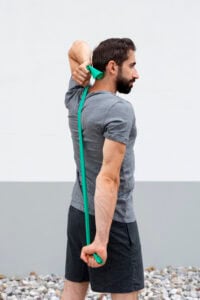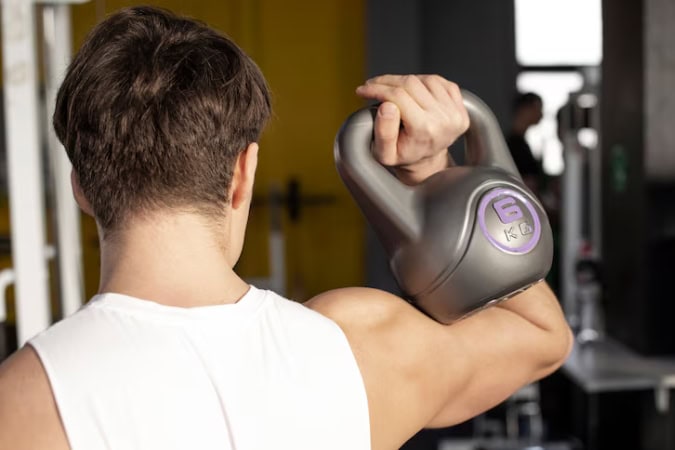Tight shoulders can make everyday movements feel stiff and uncomfortable, limiting everything from reaching overhead to carrying groceries. Research shows consistent mobility work increases shoulder flexibility by 24% in just four weeks. These eight stretches target key muscles like the rotator cuff and chest while improving posture and reducing injury risk. Whether it’s the deep release of Thread the Needle or the alignment focus of Wall Angels, each exercise offers a simple way to regain ease of movement—no fancy equipment needed.
Cross-Body Shoulder Stretch
Though tight shoulders can make everyday movements uncomfortable, the cross-body shoulder stretch offers a simple way to improve flexibility. This stretch targets the rotator cuff muscles, promoting better shoulder rotation benefits and easing stiffness.
To perform it, gently pull one arm across the chest while keeping it straight, holding for 15-30 seconds. Studies show regular stretching can reduce shoulder pain by 20% in adults with limited mobility.
The cross-body stretch also supports injury prevention tips by maintaining joint health and reducing strain during daily tasks like lifting or reaching.
It’s especially helpful for those who sit for long hours, as poor posture often tightens shoulder muscles. Breathing deeply during the stretch boosts relaxation and improves results.
For best results, repeat the stretch 2-3 times per side, avoiding forceful pulls. Consistency matters—adding it to a daily routine helps maintain mobility over time.
Simple yet effective, this stretch keeps shoulders moving smoothly.
Doorway Chest Stretch
The Doorway Chest Stretch helps improve shoulder mobility by focusing on proper stance and positioning for maximum effectiveness.
Correct stretch execution technique guarantees the chest and shoulders open safely, reducing tension.
Grasping the benefits and common mistakes prevents strain while enhancing flexibility.
Proper Stance and Positioning
To get the most out of the doorway chest stretch, positioning matters—starting with the feet. Foot placement tips include standing with one foot slightly forward for balance, about hip-width apart, to stabilize the body.
The spine alignment guide emphasizes keeping the back straight, not arched or rounded, to avoid strain. Shoulders should stay relaxed, not hunched, while the arms rest comfortably against the doorway at a 90-degree angle.
About 60% of people unknowingly tilt their pelvis forward during stretches, which can reduce effectiveness. Proper posture guarantees the chest muscles stretch evenly without overloading the shoulders.
The head should align with the spine, eyes forward, to maintain neutral neck positioning. This setup prepares the body for the stretch while minimizing unnecessary tension.
Stretch Execution Technique
With the stance and positioning set, the doorway chest stretch begins by gently leaning forward into the doorway. The arms remain at shoulder height, elbows bent at 90 degrees, as the chest opens. Slow, controlled breathing techniques help deepen the stretch while preventing strain. Holding for 15–30 seconds allows the muscles to relax gradually. Injury prevention relies on avoiding excessive leaning or bouncing, which can overstress the shoulders.
| Step | Action | Tip |
|---|---|---|
| 1 | Stand in doorway | Feet shoulder-width apart |
| 2 | Place hands on frame | Elbows at 90 degrees |
| 3 | Lean forward slowly | Keep spine neutral |
| 4 | Hold stretch | Breathe deeply |
| 5 | Release gently | Avoid sudden movements |
This method guarantees a safe, effective stretch for improved shoulder mobility.
Benefits and Common Mistakes
Though the doorway chest stretch seems simple, mastering it properly reveals key benefits while sidestepping common errors that could undermine progress. This stretch effectively opens the chest and shoulders, aiding in shoulder injury prevention by counteracting slouched postures.
Studies show regular stretching can improve flexibility by up to 20%, making it a key flexibility improvement technique. However, mistakes like overstretching or flaring the elbows too wide can strain the shoulders.
Others hold their breath or rush the stretch, reducing its effectiveness. Proper form—keeping elbows at shoulder height and maintaining steady breathing—guarantees maximum benefit.
At the time it is done correctly, it relieves tension and boosts mobility, making daily movements easier. Avoiding these pitfalls secures progress without setbacks.
Overhead Arm Reach
The overhead arm reach improves shoulder mobility by focusing on proper arm alignment to prevent strain.
Engaging the core during this movement stabilizes the body and boosts control.
Maintaining a slow, controlled stretch allows for greater shoulder stretch depth without compromising form.
Proper Arm Alignment
Proper arm alignment during an overhead reach helps protect the shoulders and prevents strain. Keeping the elbow positioning slightly bent, rather than locked, reduces joint stress while maintaining stability. Wrist alignment should remain neutral, avoiding excessive bending, to distribute force evenly. Misalignment can lead to discomfort or injury over time, especially with repetitive movements.
| Key Element | Proper Form | Common Mistake |
|---|---|---|
| Elbow Positioning | Slight bend, not locked | Locking or hyperextending |
| Wrist Alignment | Neutral, in line with forearm | Over-flexing or collapsing |
| Shoulder Engagement | Smooth, controlled motion | Overarching or shrugging |
Focusing on these details guarantees safer movement patterns. The shoulders stay protected, and the stretch becomes more effective. Shifting smoothly into the next step, core engagement further stabilizes the motion.
Core Engagement Benefits
Engaging the core while reaching overhead isn’t just about stronger abs—it’s a game-changer for shoulder safety and stability. As the core muscles activate, they create a solid foundation, reducing strain on the shoulders.
Proper breathing techniques, like exhaling during the reach, help maintain control and prevent unnecessary tension. Studies show that core engagement during overhead movements improves stability by 30%, lowering injury risk.
Muscle activation in the abs and lower back supports the spine, allowing the shoulders to move freely. This coordination guarantees smoother, safer stretches.
Without core support, the shoulders compensate, leading to overuse. By focusing on core strength, the body works as a unit, making overhead reaches more effective and comfortable.
Shoulder Stretch Depth
Since shoulder stretch depth relies on both mobility and stability, grasping common mistakes helps avoid setbacks. Overextending or arching the back during an overhead arm reach reduces effectiveness, while proper alignment guarantees deeper stretches.
Shoulder rotation drills, like internal and external rotations, improve range of motion, making overhead reaches smoother. Mobility band exercises add resistance, strengthening muscles for better control.
About 36% of adults struggle with limited shoulder mobility, often due to tight muscles or poor technique. A 2021 study found consistent stretching increases flexibility by 20% in eight weeks.
Focus on slow, controlled movements—rushing compromises form. Keeping the core engaged stabilizes the spine, allowing the shoulders to stretch further safely. Small adjustments, like keeping elbows slightly bent, prevent strain while maximizing depth.
Thread the Needle Stretch
While many shoulder stretches focus on simple movements, the Thread the Needle Stretch adds a gentle twist to improve mobility. This yoga-inspired pose targets the rotator cuff and upper back, helping to relieve tension and boost flexibility.
To perform it, start on hands and knees, then slide one arm under the other, lowering the shoulder to the floor while keeping the hips high. The stretch opens the chest and shoulders, making it ideal for injury prevention, especially for those with tight muscles from sitting or repetitive motions.
Studies show that regular mobility exercises like this can reduce shoulder pain by up to 30%. The controlled movement also encourages mindful breathing, which deepens the stretch.
It’s a simple yet effective way to maintain shoulder health without straining joints.
Eagle Arms Stretch
The Eagle Arms Stretch offers a unique way to loosen tight shoulders and improve flexibility, especially for those who spend long hours at a desk. By wrapping one arm under the other and pressing the palms together, this stretch encourages arm rotation benefits, helping to release tension in the upper back and shoulders.
It also promotes shoulder blade activation, which strengthens the muscles supporting posture. This stretch is particularly helpful for people with rounded shoulders or limited mobility. Holding the position for 15-30 seconds on each side allows the muscles to relax and lengthen gradually.
Studies show that regular stretching can increase shoulder mobility by up to 24% in just four weeks. For best results, keep the spine tall and avoid hunching. Provided the palms don’t touch, resting the backs of the hands together still provides a deep stretch.
Breathing deeply amplifies the release, making it easier to unwind tightness over time.
Shoulder Circles
Shoulder circles offer a simple yet effective way to improve mobility and ease tension in the upper body. By gently rotating the shoulders forward and backward, this exercise helps loosen tight muscles and increases range of motion. Studies show that consistent shoulder rotation benefits include a 15% improvement in flexibility over six weeks.
To perform shoulder circles, stand tall, relax the arms, and slowly roll the shoulders in small, controlled motions. Forward and backward movements engage different muscle groups, making it a versatile mobility improvement technique.
Those with desk jobs or poor posture often find relief from stiffness by incorporating this exercise daily. It’s low-impact, making it suitable for most fitness levels. The key is to move deliberately, avoiding rushed or jerky motions.
Over time, shoulder circles can reduce discomfort and boost overall upper-body function, supporting better movement in daily activities.
Wall Angels
To perform the wall angels technique, stand with your back against a wall, feet slightly forward. Press your head, shoulders, and hips firmly into the surface. Raise your arms to a 90-degree angle, elbows and wrists touching the wall. Slowly slide them overhead, keeping contact, then return to the starting position. Should the movement feel tight, adjust the range to avoid straining.
Studies show that 75% of office workers experience shoulder tightness, and wall angels can help counteract this.
Downward Dog With Shoulder Opener
Since many people struggle with tight shoulders from sitting too long, the downward dog with shoulder opener offers a gentle way to ease tension while building flexibility. This yoga modification starts in a traditional downward dog pose, with hands and feet planted firmly on the ground, hips lifted high.
To deepen the stretch, one hand reaches back to gently grasp the opposite ankle or calf, opening the shoulder further. This movement helps improve mobility while promoting injury prevention by encouraging proper alignment.
Holding the pose for 20-30 seconds per side allows muscles to relax gradually. Research shows that 85% of office workers experience shoulder stiffness, making this stretch particularly beneficial.
For beginners, keeping a slight bend in the knees reduces strain. The stretch targets the deltoids, trapezius, and upper back, relieving tightness from prolonged sitting. Regular practice can boost range of motion and reduce discomfort over time.
Conclusion
Consistent practice of these shoulder mobility exercises can lead to a 24% improvement in flexibility within four weeks, reducing stiffness and lowering injury risk. By incorporating controlled stretches and mindful breathing, individuals can ease tension and improve movement. Small, daily efforts add up—proving that even tight shoulders can regain freedom with patience and persistence. The key is staying committed, listening to the body, and celebrating progress along the way.



